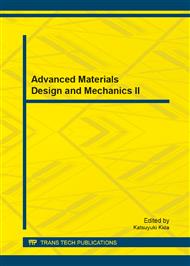[1]
C. Chappert, A. Fert, F. Nguyen Van Dau, The emergence of spin electronics in data storage, Nature Materials. 6 (2007) 813-823.
DOI: 10.1038/nmat2024
Google Scholar
[2]
P. Padhan, W. Prellier, Effect of strain on the electrical transport and magnetization of Pr0. 5Ca0. 5MnO3/La0. 5Ca0. 5MnO3/Pr0. 5Ca0. 5MnO3 trilayer structures, Phys. Rev. B. 72 (2005) 094407.
Google Scholar
[3]
S. Y. Park, Y.H. Hyun, Y. P. Lee, V. L. Svetchnikov, K.W. Kim, V.G. Prokhorov, Evidence for the charge-ordered state and phase separation at room temperature in half-doped La0. 5Ca0. 5MnO3 films, Appl. Phys. Lett. 89 (2006) 052502.
DOI: 10.1063/1.2243340
Google Scholar
[4]
T. Z. Ward, Z. Gai, X.Y. Xu, H.W. Guo, L.F. Yin, J. Shen , Tuning the metal-insulator transition in manganite films through surface exchange coupling with magnetic nanodots, Phys. Rev. Lett. 106 (2011) 157207.
DOI: 10.1103/physrevlett.106.157207
Google Scholar
[5]
D. Niebieskikwiat, L. E. Hueso, J. A. Borchers, N. D. Mathur, M. B. Salamon, Nanoscale magnetic structure of ferromagnet/antiferromagnet manganite multilayers, Phys. Rev. Lett. 99 (2007) 247207.
DOI: 10.1103/physrevlett.99.247207
Google Scholar
[6]
J. Hoppler, J. Stahn, Ch. Niedermayer, V. K. Malik, H. Bouyanfif, A. J. Drew, M. Rössle, A. Buzdin, G. Cristiani, H. -U. Habermeier, B. Keimer, C. Bernhard, Giant superconductivity-induced modulation of the ferromagnetic magnetization in a cuprate-manganite superlattice, Nature Materials. 8 (2009).
DOI: 10.1038/nmat2383
Google Scholar
[7]
D. K. Satapathy, M. A. Uribe-Laverde, I. Marozau, V. K. Malik, S. Das, Th. Wagner, C. Marcelot, J. Stahn, S. Brück, A. Rühm, S. Macke, T. Tietze, E. Goering, A. Frañó, J. -H. Kim, M. Wu, E. Benckiser, B. Keimer, A. Devishvili, B. P. Toperverg, M. Merz, P. Nagel, S. Schuppler, C. Bernhard, Magnetic proximity effect in YBa2Cu3O7/La2/3Ca1/3MnO3 and YBa2Cu3O7/LaMnO3+δ superlattices, Physical Review Letters. 108 (2012).
DOI: 10.1103/physrevlett.108.197201
Google Scholar
[8]
H.O. Wang, P. Dai, H. Liu and W. S. Tan, F. Xu, X. S. Wu, Q. J. Jia, G. J. Hu, J. Gao, Magnetic and transport properties of Pr0. 7Sr0. 3MnO3/La0. 5Ca0. 5MnO3/ Pr0. 7Sr0. 3MnO3 trilayers, Int. J. Mod. Phys. B. 26 (2012) 1250132.
DOI: 10.1007/s12034-014-0624-y
Google Scholar
[9]
REFS Reflectivity Simulation Software (Bede Scientific Instruments, Lindsey Park, Durham, UK, 1996).
Google Scholar
[10]
W. S. Tan, X.S. Wu,J. Du, J.S. Liu, A. Hu, S.S. Jiang, J. Wang, Z.H. Wu, W. L. Zheng, Q.J. Jia, J. Gao, Microstructures and resistivity of cuprate/manganite bilayer deposited on SrTiO3 substrate, J. Appl. Phys. 93 (2003) 8215.
DOI: 10.1063/1.1541653
Google Scholar
[11]
S. -W. Han, S. Tripathy, P. F. Miceli, E. Badica, M. covington, L. H. Greene ,M. Aprili, X-ray reflectivity study of interdiffusion at YBa2Cu3O7-x and metal interfaces, Jpn. J. Appl. Phys. 42 (2003) 1395-1399.
DOI: 10.1143/jjap.42.1395
Google Scholar
[12]
S. -W. Han, J.A. Pitney, P.F. Miceli, M. Covington, L.H. Greene, M.J. Godbole, D.H. Lowndes, X-ray reflectivity study of thin film oxide superconductors, Physica B. 221 (1996) 235-237.
DOI: 10.1016/0921-4526(95)00931-0
Google Scholar
[13]
G. Palasantzas , Y.P. Zhao, J. Th. M. De Hosson, G. C. Wang, Roughness effects on magnetic properties of thin films, Physica B. 283 (2000) 199-202.
DOI: 10.1016/s0921-4526(99)01939-0
Google Scholar
[14]
J. Swerts, K. Temst, N. Vandamme, C. Van Haesendonck, Y. Bruynseraede, Interplay between surface roughness and magnetic properties in Ag/Fe bilayers, Journal of Magnetism and Magnetic Materials. 240 (2002) 380-382.
DOI: 10.1016/s0304-8853(01)00832-0
Google Scholar
[15]
A. Maitre, D. Ledue, R. Patte, Interfacial roughness and temperature effects on exchange bias properties in coupled ferromagnetic/antiferromagnetic bilayers, Journal of Magnetism and Magnetic Materials. 324 (2012) 403-409.
DOI: 10.1016/j.jmmm.2011.07.049
Google Scholar
[16]
S. Colis, G. Schmerber, A. Dinia, Correlation between magnetic and transport properties of Co/Ir/Co sandwiches and surface roughness, Thin Solid Films. 380 (2000) 137-141.
DOI: 10.1016/s0040-6090(00)01488-7
Google Scholar


